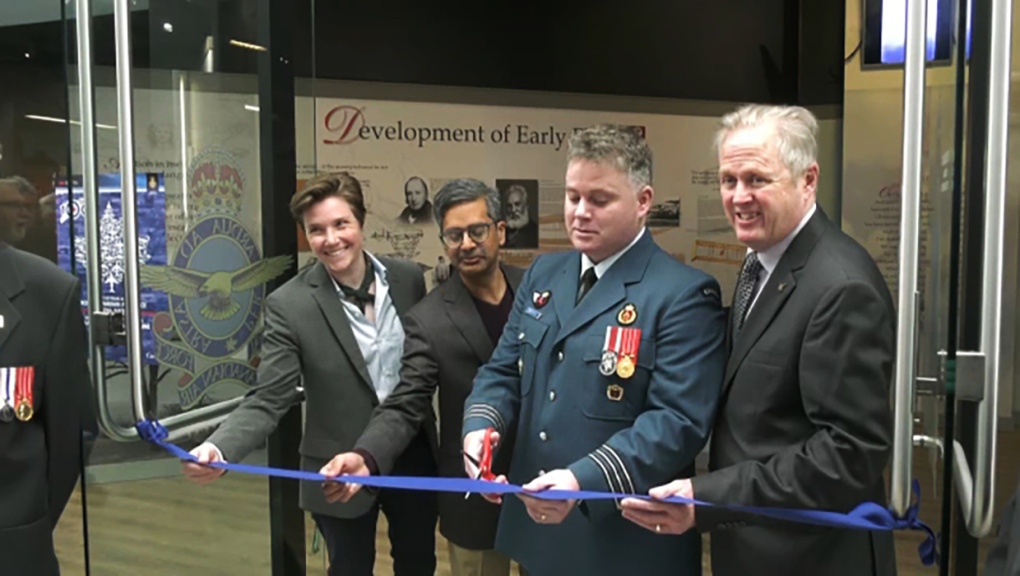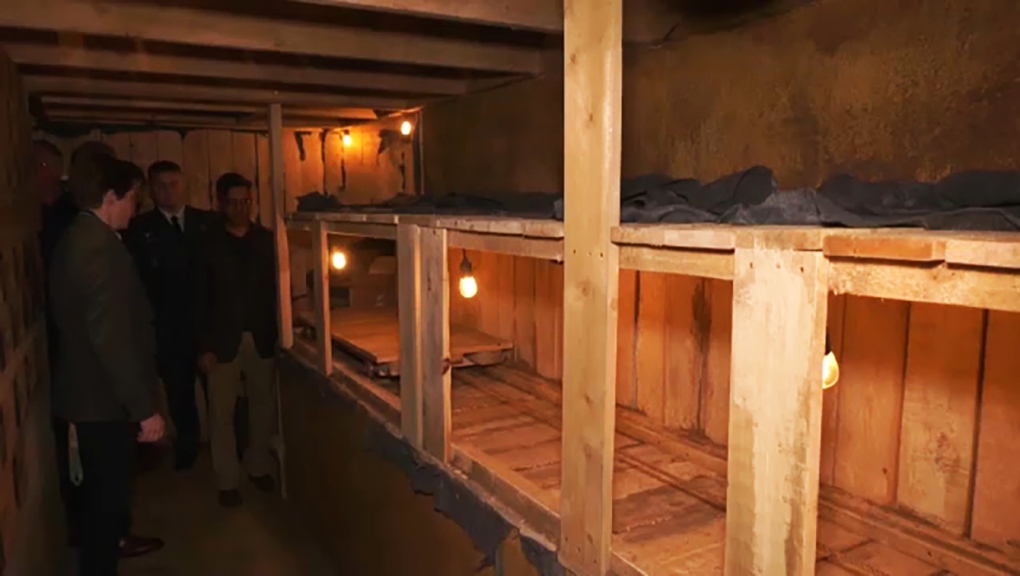New exhibit at The Military Museums in Calgary pays tribute to the Great Escape
Many late-night TV watchers have heard of or even seen the movie The Great Escape. Now, thanks to a new exhibit from Calgary's Military Museums, fans of the film can learn the true story that inspired the movie.
It starred James Garner and Steve McQueen, among others, and details how a group of allied prisoners of war launch an escape effort from Stalag Luft III.
Few may realize the 1963 movie was based on an actual great escape largely driven by Canadian soldiers.
ESCAPE FROM STALAG LUFT III
On March 24, 1944 Allied prisoners of war launched the largest escape effort of the Second World War. Seventy-six men escaped via a 300-foot-long (91 metre) tunnel dug deep below the confines of the German-held Stalag Luft III POW camp.
Many of the men involved in this escape initiative were Canadian and brought unique skill sets gained in pre-war life to the complex operation.
“There were people that were designated as tailors to make German uniforms, civilian clothes, there are people designated to reproduce and print identification cards and travel passes. We had several people who were there just to dig the tunnel and get rid of the dirt from the tunnel,” says Kenn Nixon chair of the RCAF 2024 committee.
“The ingenuity of the people to do all this was amazing," he added. "Since they were all intelligent, great people, they had trades people in there. They had pilots, navigators, these people were all civilians before the war, doing jobs that they were able to take advantage of so the great escape was a collaborative effort.”
 On March 24, 1944 allied prisoners of war launched the largest escape effort of the Second World War.
On March 24, 1944 allied prisoners of war launched the largest escape effort of the Second World War.
80TH ANNIVERSARY SHOW
On the 80th anniversary of that event; The Military Museums officially opened The Great Escape Exhibit.
The exhibit honours all those in Stalag Luft III, and particularly those involved with the digging and escape through the tunnel known as ‘Harry’.
Sons of two of the POWs in Stalag Luft III attended Sunday’s official opening and spoke about the roles their fathers played in the escape attempt.
Barry Davidson Jr. is the son of Royal Air Force Pilot Officer Barry A. Davidson. He was one of the longest serving World War II POW (five years) who survived the great escape at Stalag Luft III.
P/O Davidson specialized in bribing and blackmailing the German guards and hut searchers.
The contents of Red Cross packages like chocolate, Nescafe, and cigarettes became currency in exchange for paper, India ink, pen nibs, and even a camera critical for forging travel documents.
He also obtained important items such as train schedules, uniform insignias, passports, travel permits and even lock picks and timber were also obtained. It was through these efforts that his father became known as “the scrounger.”
James Garner portrayed his father in the movie The Great Escape.
“I'm very involved in several veterans, service organizations and this because it's so close to home is very hard. It just touches the heart,” says Davidson.
“It's also critically important because it's one of those areas that is often not talked about and with the current turmoil in the world, these are the type of displays, exhibits and information that needs to get out there so that we understand the high cost of war and what our freedom actually costs and actually celebrate the people that allow us to be free.”
NAVIGATOR
Paul Tobolski is the son of Pawel Tobolski. He was a Polish-born Royal Air Force navigator, who took part in the great escape using one of the tunnels at Stalag Luft III on the night of March 24, 1944.
Just 76 individuals out of the initially planned 200 made it out of the tunnel that night. Of these, 73 were recaptured and only three made it back to England. Unfortunately, 50 of the recaptured escapees, Pawel Tobolski included, were murdered under Hitler’s orders in contravention of the Geneva Convention, as an example to other POWs not to escape.
Pawel’s wife, Jadwiga, was four months pregnant when Pawel left for his bombing mission and was shot down on June 25th 1942, ending up in Stalag Luft III. Their son, Paul, was born while Pawel was in Stalag Luft III. Handwritten letters his mother received from her husband Pawel in the POW camp detailed his excitement on the birth of his son in November, 1942.
The Great Escape Experience provides an immersive, interactive re-telling of this significant Second World War event including a recreated POW hut with escape-related accessories and a length of the escape tunnel itself, built to the same height and width of the original.
Visitors are invited to traverse the tunnel to get a sense of the tense, claustrophobic conditions of the original tunnel.
 The exhibit features recreations of the narrow tunnels that prisoners dug to escape.
The exhibit features recreations of the narrow tunnels that prisoners dug to escape.
“I hope that they feel some of the resilience, some of the bravery and honor that these people had, in order not just to survive, but in their continued effort to make the world a better place. I hope that by reading and by looking at the displays and seeing it and seeing what they went through, that we realized that we can overcome huge obstacles and make things better,” said Davidson.
The Great Escape Exhibit is located in the Air Force Museum at the Military Museums and will remain a place where these individuals will be remembered and honoured.
“This particular exhibit is not just words on the wall. It's a place where people can touch things, know what it's like to look at a bunk that you're going to have to sleep on with another 25 people in the room. You know, the thought of teamwork that has made the greatest gift possible. Those are all things that are important. They show the ingenuity of people and we need that kind of ingenuity,” said Nixon.
This is an initiative conceived and funded by the Air Force Museum Society of Alberta.
CTVNews.ca Top Stories

The world begins welcoming 2025 with light shows, embraces and ice plunges
From Sydney to Vladivostok, communities around the world have begun welcoming 2025 with spectacular light shows, embraces and ice plunges.
ATM stolen after excavator crashes into North York bank: Toronto police
Police say a North York financial institution has sustained “significant damage” after an excavator reportedly crashed into the building early Tuesday morning and an ATM was stolen.
Ottawa family returns home after chaotic Costa Rica trip
After spending almost 48 hours longer than intended in Costa Rica, the Sachs family has finally returned home.
Nearly all of Puerto Rico is without power on New Year's Eve
A blackout hit nearly all of Puerto Rico early Tuesday as the U.S. territory prepared to celebrate New Year's Eve.
WATCH A jet carrying the Gonzaga men's basketball team ordered to stop to avoid collision at LAX
The Federal Aviation Administration has launched an investigation after a private jet carrying the Gonzaga University men's basketball team nearly crossed a runway as another flight was taking off Friday at Los Angeles International Airport.
2 Oregon men die from exposure in a forest after they went out to look for Sasquatch
Two Oregon men were found dead in a Washington state forest after they failed to return from a trip to look for Sasquatch, authorities said Saturday.
Angelina Jolie and Brad Pitt reach divorce settlement after 8 years
Angelina Jolie and Brad Pitt have reached a divorce settlement, ending one of the longest and most contentious divorces in Hollywood history but not every legal issue between the two.
Bernie Madoff's victims have now recovered 94% of their losses
A U.S. government fund created to compensate thousands of people scammed by the late Bernie Madoff in history's biggest Ponzi scheme is making its final batch of payments — and it has now made up nearly all of their losses.
The Pentagon chief loses bid to reject 9/11 plea deals
A military appeals court has ruled against Defense Secretary Lloyd Austin's effort to throw out the plea deals reached for Khalid Sheikh Mohammed and two other defendants in the 9/11 attacks, a U.S. official said.
































